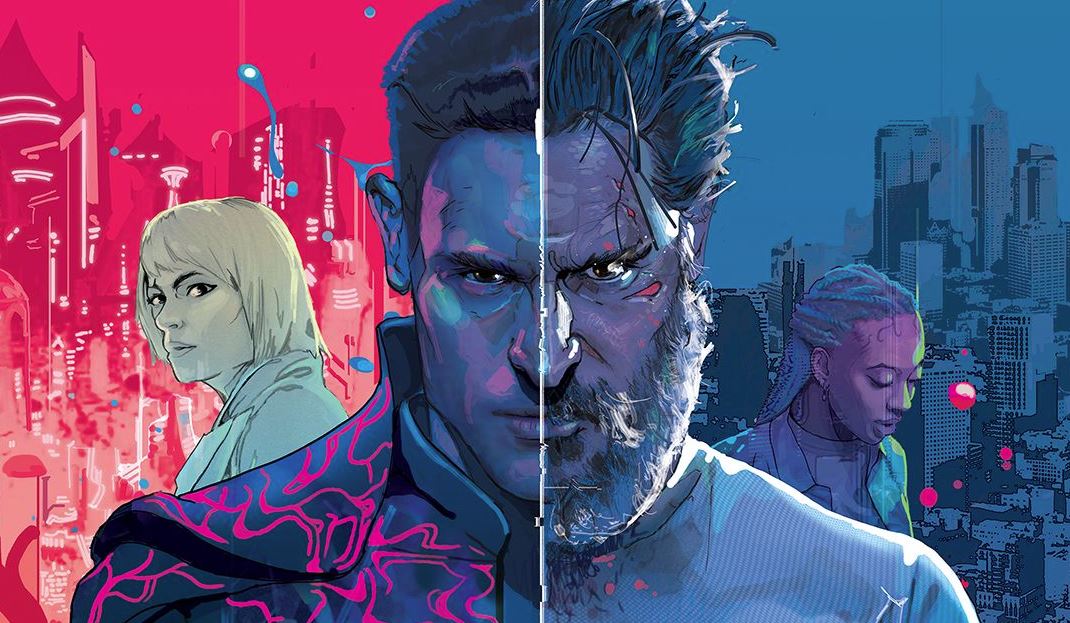Adam Egypt Mortimer is a writer and director with an incredible eye for visuals and a deep love of challenging genre film. His first two feature-length projects, the horror films SOME KIND OF HATE and DANIEL ISN’T REAL, earmarked him as not only a filmmaking talent worth paying attention to but as someone where whatever he does next should be eagerly anticipated.
Well, his latest film has arrived and it again finds him diving head first into a genre, in this case superhero stories, and using that vehicle to explore deeper ruminations on the human condition… while at the same time delivering a darkly entertaining story filled with all the violence, outlandish characters, and even more outlandish visuals that his fans have come to expect from his work.
That film is ARCHENEMY. It stars Joe Manganiello (TRUE BLOOD) as a homeless man, named Max, who tells seemingly insane stories about being a fallen superhero from another dimension that have caught the attention of a young blogger (Skylan Brooks, SOUTHPAW) looking for his big break. As the two begin to form a friendship, a crisis arises that will give Max the chance to be the hero he has always claimed he was…
I had the opportunity recently to talk with Adam Egypt Mortimer about his love of comic books, the joy of shooting action scenes, and all things ARCHENEMY.
_________________________________
What led to the creation of ARCHENEMY?
I always have loved comic books. I’ve never stopped reading comics. I started writing this movie around 2015, and I felt like, that the people who are going to see superhero movies are ready to be treated as sophisticated as people who read comics. You know what I mean? Like all the way back in the 1980s when Frank Miller and Bill Sienkiewicz did ELECKTRA: ASSASSIN, they’re really saying, “Okay, you get what a superhero is. You understand these mythologies. You understand the source. What if we just completely rethink how we can experiment with the form and the aesthetics and how we tell those kinds of stories?”
There has been so much of that kind of work in comics. And I felt like, “All right, I think we’re ready. I think we can do it. Let’s do that in movies now. Let’s do a superhero story that doesn’t feel like the same kind of genre. What if we do a superhero story that feels like, oh, it’s a emotional tragedy, oh, it’s a crime movie, oh, it’s kind of psychedelic. How could we shake up what a superhero movie can be?”
So, I started thinking about a character who maybe keeps this shredded cape in a box, and he hangs out at a bar, and he’s drinking whiskey, and he’s telling everybody, “Oh, I used to fly through black holes,” but nobody really believes them. And it’s just kind of a tragic story, sort of like Darren Aronofsky’s THE WRESTLER in a way. That was all of the original soup that it came out of.
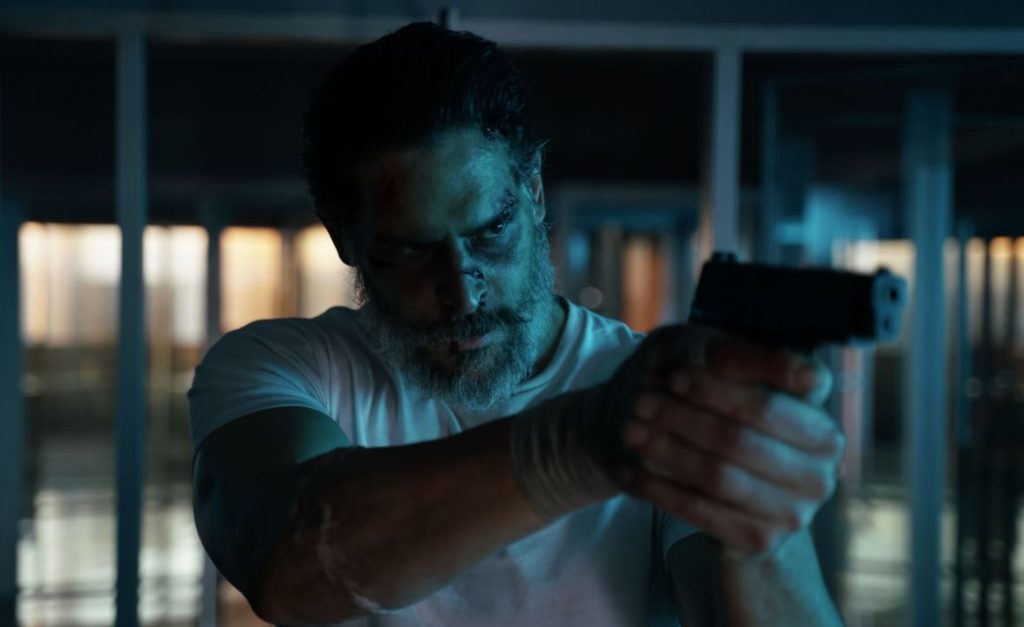
I completely agree about the notion that movie-going audiences are now so familiar with the format of superhero stories that they can fully appreciate a deconstruction of the form. You’ve got a great lead to help bridge that gap between telling a traditional superhero narrative and doing something more unconventional in Joe Manganiello. It’s hard to imagine anyone else in the role. I’ve read that he wasn’t the original choice though. Tell me a bit about the casting process for the character of “Max Fist” and how Joe ultimately came into the role.
Well, because I was making this movie with SpectreVision, the producers, they had just MANDY and COLOR OUT OF SPACE with Nicolas Cage. So, we gave Cage the script and I met with him and we had lunch, and he was pretty stoked about it. And I was stoked to have him because in my mind I felt like this movie really was… It’s a cross between Superman and LEAVING LAS VEGAS, and Cage was in LEAVING LAS VEGAS, and he had always wanted to be Superman. It seemed perfect. We had a really great conversation. And then it didn’t work out because of scheduling and timing and budget and whatever, however nothing ever works out in the movie business, so that’s not unusual.
But then I met Joe under similar circumstances. He had wanted to work with SpectreVision also. He was like, “I want to do a movie like MANDY. I want to do psychedelic weird action-horror.” And we showed him my last movie, DANIEL ISN’T REAL, and he liked that. Then when he read the script for ARCHENEMY, it’s a perfect thing for him and he saw that. I mean, Joe, he is Superman in so many ways, and he loves this kind of action hero character. He’s so good physically. He loves to tackle people and do his own stunts. He also really vibed on the idea that this is an opportunity for him to dig deeper as an actor and show this tragic emotional side that he’s so capable of.
So, we got together and started talking, and he’s a huge comic book fan also. So, we started getting in there, and we were talking about Grant Morrison’s ALL-STAR SUPERMAN, and Frank Miller, and there was just such a vibe. I mean, you wind up with the perfect guy for the job however you start, and that was true here. Joe really just became Max. I can’t imagine anybody else doing it either.
He’s such an imposing figure, yet he has a real emotionally vulnerable quality.
Right?! He has this charm, and we all know he’s charming, but I think the thing that was exciting was to see him be able to play somebody who’s so broken and so lonely and who wants something. So that way, when we get to the gun fights and the action scenes, it’s coming from this place of rage and hopelessness. He can act with his body in this really specific way that may be surprising to those that aren’t more familiar with him.
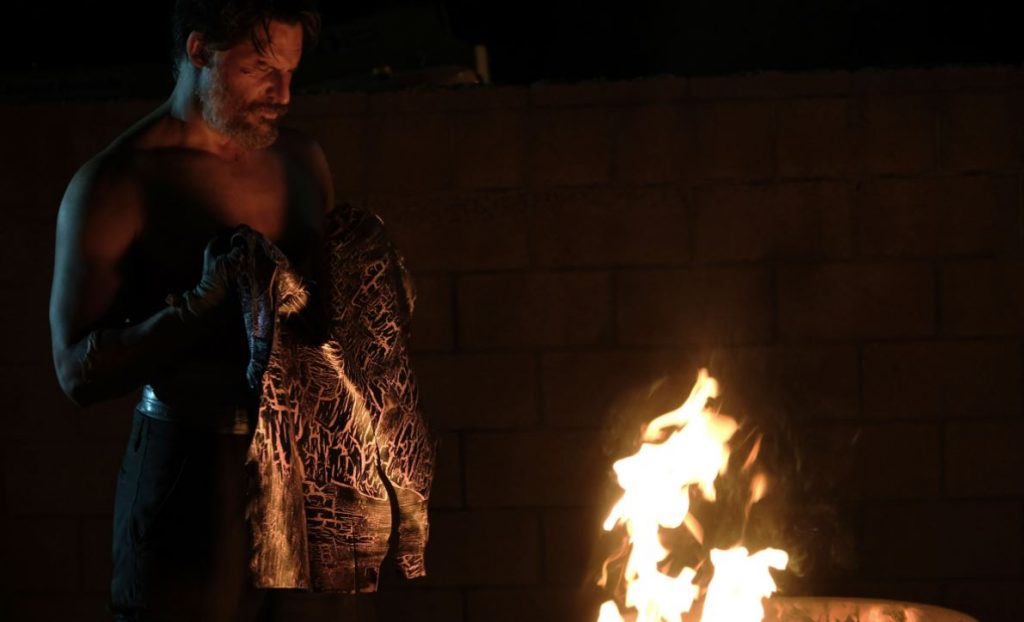
Speaking of the action scenes, you have been classified as a “horror” directory by many. Your previous films though have strong moments of action and ARCHENEMY takes you even further into the realm of action filmmaking. What are your thoughts on doing more action-oriented filmmaking?
Well, I mean, action directing is just the greatest. It’s what movies can do like no other form. I mean, I love a good emotional interaction and a good bit of communication, but that’s also what you can do in theater. But in an action sequence where you’re thinking about how do you move people through space and show violence and excitement and fear and tension and move the camera around? That’s the coolest part. Not to say that action movies are the coolest movies but being able to express these things in this physical way is the greatest thing that the movies can do. And it’s true if you talk about a Christopher Nolan movie or a Charlie Chaplin movie, moving people through space is just so awesome.
And one of the things that I was excited to put in this movie is there’s this one action sequence that’s entirely slow-motion. It’s sort of designed to feel almost like a religious experience. Like here’s a guy who’s been so broken down by the circumstances he’s in and he can’t get anywhere, and he shuffles around drinking. Then he starts fighting people and in this moment he finds his purpose, and it’s like he’s transcended.
So, we’re showing that with this crazy slow-motion sequence and people are trying to shoot at each other at point blank range and there’s insane music. And I loved the idea of being able to use action in a way that would be exciting, but also have it be almost psychedelic and have this emotional quality to it as well. If you can tell an emotional story through action, that’s the best kind of movie.
One thing that struck me about the sequence you are referring to is that the slow-motion look was very unique. It really recalled the way scenes in actual comic books are framed in the panels on the page. It causes the eye to really focus on the way the figures are posed in the sequence.
That’s fascinating. There’s a comic book artist named Jim Steranko who goes all the way back to the ’60s who I love. He did a lot of work on Nick Fury comic books. I brought a big collection of his Nick Fury work with me when we started working on the movie and shared it with my cinematographer, and she just loved it. We would circle panels and look at sort of like visual things that he would do and figure out how to translate it into the movie. So that was an influence, even while we were also trying to sort of make some things feel very real – people walking around on the sidewalk and it’s gritty and hanging out.
But then also, how do we be sort of graphical, and not in a way where we’re trying to evoke comic books directly, like quoting them or reminding you that it’s sort of about superheroes. Sometimes the best cinematic images are actually drawn on the page in a comic book, and then it becomes how do you not fuck that energy up when you convert it into a moving image?
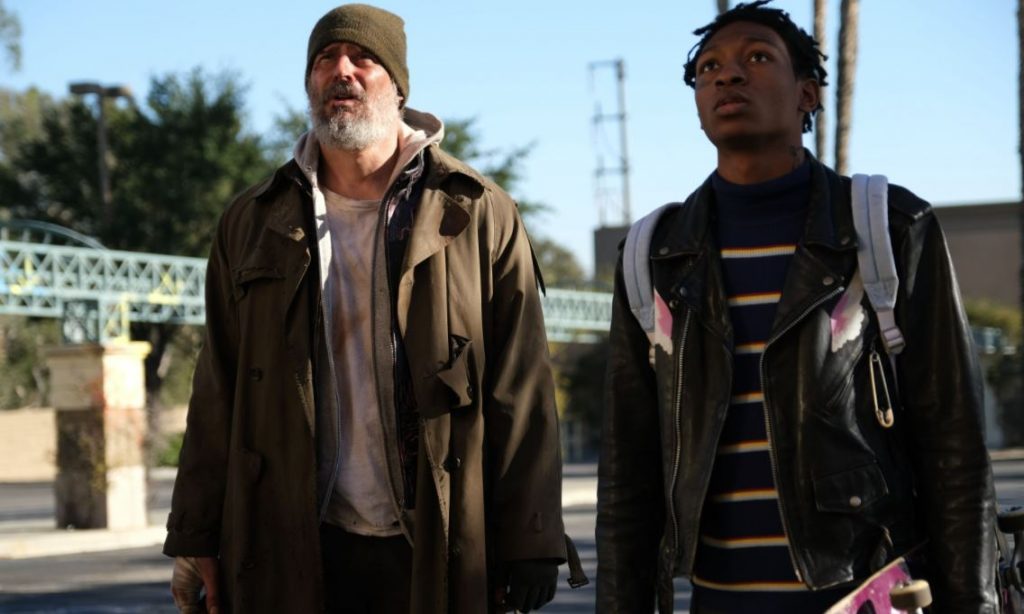
I think you really captured that energy here. So, I want to ask you about a couple of very specific things in ARCHENEMY. The first is the comic book-style inserts and animations used to represent Max’s previous reality. What went into their creation?
I wanted to make sure that all of that stuff felt expressionistic instead of very, very real. It’s like the world that we’re in that’s very real. It’s gritty. There’s drug dealers, there’s cement, there’s dirt. But the world that he talks about has to feel a little bit like you’re trying to remember a dream. You’re trying to remember if something really happened or maybe you’re telling a made-up story. And so it had to feel a little bit blurry and focus more on the feeling of it than the specifics of it, which is why it’s these bright, bright, intense colors of pink and blue and this sort of alien crystal music that’s kind of pulling you in.
So, I worked with a comic book artist named Sunando who understood this vibe and understood when I would go on and on about Bill Sienkiewicz and Frank Miller comics. And we just worked with two other people to help him with it, a guy named Danny Perez who created all the kind of psychedelic worlds and trippy visual type stuff, and then Kevin Finnegan who did all of the animation and brought it all together into the software to make things move.
We were really going for this feeling of waking up out of a dream. And you would see there’s little trails of it. Sometimes he wakes up and there’s still a little bit of animation or right when he starts telling a story, it grows up behind him. Which in a way, I honestly was a little bit influenced by WHO FRAMED ROGER RABBIT? I’m talking about these… I was like, “I need more Roger Rabbit transitions,” and they would go, “What the hell are you talking about?”
[Both laugh]
That feeling… sometimes when I try to remember dreams, it feels a little bit blurry and ethereal. And so, we wanted it to be depicting what he feels like at the moment that he’s telling these stories, not necessarily depicting the reality of them.
The second thing I have to ask about is Paul Scheer [THE LEAGUE]. His one scene is wild. It’s so completely different than what he normally does. How did that all come together?
He’s so great. I’m so glad he did it. I was able to put Paul in the movie because he saw Daniel Isn’t Real at South by Southwest and came up to me afterwards and said, “Hey, that was a cool movie.” And I just grabbed him, and I was like, “You got to be in my next film.” And I’d written this character knowing that this scene with this character is completely insane. It’s such a wild character. And there was just no question, once I sent him the script, and he was like, “Hell yeah,” it wasn’t even a question of, well, I don’t know, is he the right guy? Of course, he’s the right guy. Paul Scheer can just create magic out of nothing. And it was always in the script, his costume is just going to be red underwear, although the costume designer had the brilliant idea to add snakeskin boots. And he was just so comfortable being the most insane character in the whole movie and sitting there with his bottles of whiskey and his crushed pills and the guns and his just tattoos on his face. I mean, I’ve never felt such delight.
This is also a movie with such a limited budget and such limited time, and we’re constantly running around. And that day with Paul, we actually were able to spend the entire day shooting that scene because it had to have this progression- this game of chess between the two of characters and it gets more and more crazy. And so, that scene, It’s a real joy for me, both how I think people will react to it and how wonderful it was to shoot Paul in it.
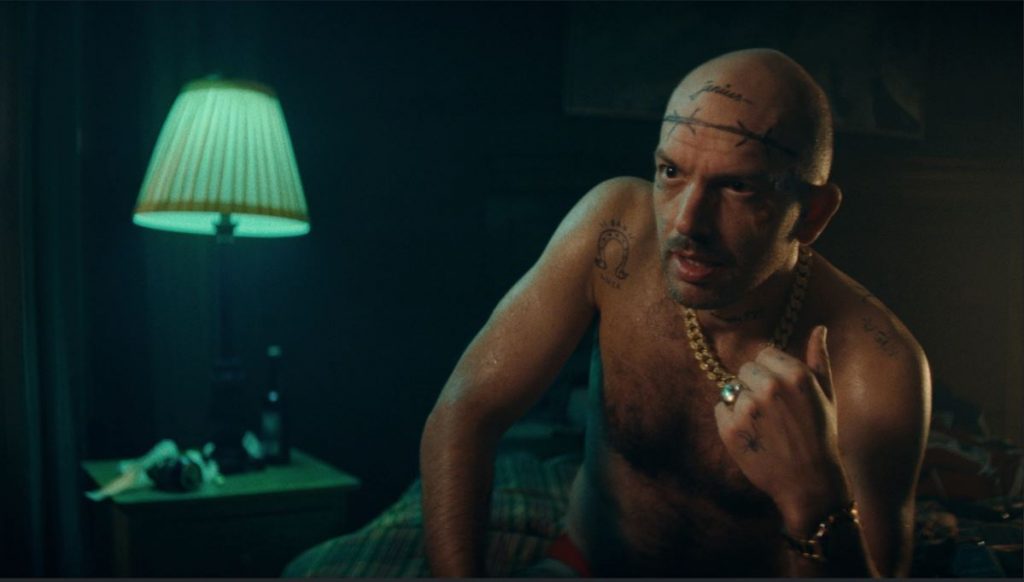
It’s a real jolt of energy in the film and it really captures your attention. So, I’m going to put on my film critic hat for a moment and ask you a question about theme. In your previous films and now with ARCHENEMY, I’ve noticed an underlying thought of people grappling with the idea of who they are. Where does that come from?
I don’t know. I think that’s true in everything I do. Even if you look back at my first movie, which was very small, and I was still learning how to make a movie, but in a similar way it has this relationship like in DANIEL ISN’T REAL between a kid and this demonic figure that they evoke that is there for their rage. I think for me, I’m interested in movies to help me tell a story about what it feels like to be a person, starting from what’s it feels like to be me. If that makes sense?
And I have no idea how I would make a movie like an Ingmar Bergman film. I have no idea how it could be done. It’s a family dinner, but all of the truths of the universe and the soul come out in that conversation. I wish I could do that, I love watching it, but I have no idea how to do that. But if I can start with these feelings of, “Oh, I’m bummed out about who I am,” or, “I wish I was somewhere else in my career. I wish I didn’t do mean things sometimes,” whatever these unhappy feelings we have. And a lot of times it goes back to a terrible breakup I had. I’ve been divorced and that’s just awful. How do I take that feeling and translate it into something that is external and action-packed or scary?
So, I think it’s about that, this combination of “I love genre so much” and I want to say, “I’m going to do a possession movie. I’m going to do a superhero movie,” but then as soon as I start going down that path, the people in it have to be so real. And so then, I can only get them real by thinking about my own feelings about being a person and then it all goes to hell. Everybody’s jumping to their deaths and lighting themselves on fire, and it’s quite horrible, but that’s where it starts.
I think it’s cathartic. It helps you work through those feelings. I think that’s the case for the audience as well.
Well, that’s my hope is that it’s like if I feel certain ways and I feel them very strongly, and then I try to use the way that I make movies to make things really overwhelming. I think Daniel Isn’t Real was about a really overwhelming sense of anxiety. And it’s just this non-stop pounding, orchestral feeling and movement. And with this movie, there’s a sort of overwhelming psychedelic confusion and what is real? And am I really who I say I am? And if I can take those feelings and then make them really big and unrelenting, then I feel like we all watched the movie I made and we all have the same feeling that we can relate to and go, “Oh, fuck, yeah, I felt like that too.”
I really hope… I think it transcends theme and goes to being, like you said, cathartic. I think that’s right. It’s like this unified understanding of us all feeling these difficult things together is actually really helpful.
_______________________________
RLJE Films will release the action/thriller ARCHENEMY In Theaters, On Digital and On Demand December 11, 2020.






